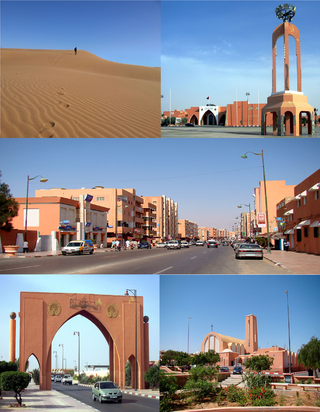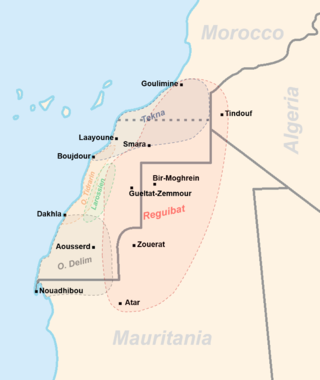
Morocco, officially the Kingdom of Morocco, is a country in the Maghreb region of North Africa. It overlooks the Mediterranean Sea to the north and the Atlantic Ocean to the west, and has land borders with Algeria to the east, and the disputed territory of Western Sahara to the south. Morocco also claims the Spanish exclaves of Ceuta, Melilla and Peñón de Vélez de la Gomera, and several small Spanish-controlled islands off its coast. It spans an area of 446,300 km2 (172,300 sq mi) or 710,850 km2 (274,460 sq mi), with a population of roughly 37 million. Its official and predominant religion is Islam, and the official languages are Arabic and Berber; French and the Moroccan dialect of Arabic are also widely spoken. Moroccan identity and culture is a mix of Arab, Berber, African and European cultures. Its capital is Rabat, while its largest city is Casablanca.

Demographic features of the population of Morocco include population density, ethnicity, education level, health of the populace, economic status, religious affiliations and other aspects of the population. The population of Morocco in 2021 is 37.271 million.

Sub-Saharan Africa, Subsahara, or Non-Mediterranean Africa, is the area and regions of the continent of Africa that lie south of the Sahara. These include Central Africa, East Africa, Southern Africa, and West Africa. Geopolitically, in addition to the African countries and territories that are situated fully in that specified region, the term may also include polities that only have part of their territory located in that region, per the definition of the United Nations (UN). This is considered a non-standardized geographical region with the number of countries included varying from 46 to 48 depending on the organization describing the region. The African Union (AU) uses a different regional breakdown, recognizing all 55 member states on the continent—grouping them into five distinct and standard regions.

The history of Western Sahara can be traced back to the times of Carthaginian explorer Hanno the Navigator in the 5th century BC. Though few historical records are left from that period, Western Sahara's modern history has its roots linked to some nomadic groups such as the Sanhaja group, and the introduction of Islam and the Arabic language at the end of the 8th century AD.

All data about demographic information regarding Western Sahara are extremely error-prone, regardless of source. Most countries take censuses every ten years, and some every five in order to stay abreast of change and miscounts; the last count was conducted in 1970, and even that data by colonial Spain is considered unreliable due to large nomadic populations.

The Maghreb, also known as the Arab Maghreb and Northwest Africa, is the western part of the Arab world. The region comprises western and central North Africa, including Algeria, Libya, Mauritania, Morocco, and Tunisia. The Maghreb also includes the disputed territory of Western Sahara and the Spanish cities Ceuta and Melilla. As of 2018, the region had a population of over 100 million people.

Laâyoune or El Aaiún is the largest city of the disputed territory of Western Sahara, with a population of 271,344 in 2023. The city is de facto under Moroccan administration. The modern city is thought to have been founded by the Spanish captain Antonio de Oro in 1938. From 1958, it became the administrative capital of the Spanish Sahara, administered by the Governor General of Spanish West Africa.

The Sahrawis, or Sahrawi people, are an ethnic group and nation native to the western part of the Sahara desert, which includes the Western Sahara, southern Morocco, much of Mauritania, and along the southwestern border of Algeria. They are of mixed Hassani Arab and Sanhaji Berber descent, as well as Sub-Saharan African and other indigenous populations.

The Western Sahara has an established music tradition. Many of the well-known from the country musicians have settled in Dakar, where they mingled further with musicians from West Africa.

Sahrauis: The Music of the Western Sahara is a three-disc box set of Saharawi music, published by the Spanish label Nubenegra. It was the first compilation of such songs released in the United States. The producers of the album travelled to the Sahrawi refugee camps and spent 14 days with the artists to record the CDs 1 & 2 of the compilation, with the aim of recording with the finest musicians and singers the traditional Sahrawi music (Haul) of the past and present.

Morocco- sovereign country located in western North Africa. Morocco has a coast on the Atlantic Ocean that reaches past the Strait of Gibraltar into the Mediterranean Sea. It has international borders with Algeria to the east, Spain to the north, and a disputed border with Western Sahara to the south.

Mauritania, officially the Islamic Republic of Mauritania, is a sovereign country in Northwest Africa. It is bordered by the Atlantic Ocean to the west, Western Sahara to the north and northwest, Algeria to the northeast, Mali to the east and southeast, and Senegal to the southwest. Mauritania is the 11th-largest country in Africa and the 28th-largest in the world, and 90% of its territory is situated in the Sahara. Most of its population of 4.4 million lives in the temperate south of the country, with roughly one-third concentrated in the capital and largest city, Nouakchott, located on the Atlantic coast.

Mariem Hassan was a Sahrawi singer and lyricist from Western Sahara. She usually sang in Hassaniyya, an Arabic dialect spoken mostly in Western Sahara and Mauritania, and occasionally in Spanish. Her use of the Spanish language was related to the former status of Western Sahara as a Spanish colony.
Najm Allal is a singer, guitarist and writer of lyrics in Spanish from Western Sahara.

Aziza Brahim is a Sahrawi singer and actress.

Mariem Hassan, la voz del Sáhara is a 2007 documentary film directed by Manuel Domínguez.

Deseos is the 2005 debut solo album of the Sahrawi singer Mariem Hassan. The album was recorded at Axis estudios in Madrid, and produced by guitarist Baba Salama, who died of leukemia one week before the release of the album. With the use of two electric guitars and two tbals, the album had been hailed as a fresh actualization of the traditional Sahrawi Haul traditional music. The song "La Tumchu anni" is one of the highlights, a picturesque desert blues. It also contains one of Mariem's most known songs, "La Intifada", about the 2005 Sahrawi Independence Intifada. "El Chouhada" is dedicated to her three dead brothers, who were killed fighting during the Western Sahara War, while in "Mutamaniyat" she asks God for the healing of her breast cancer.

Mi Canto is the debut solo digital ep of Sahrawi singer Aziza Brahim. It was released worldwide on 12 January 2009 by the French label Reaktion, reaching shortly after number one on the World music list of the web Emusic.com. Brahim, who produced the album herself, is accompanied by her band Gulili Mankoo in the recording.
Saharan Spanish is the variety of the Spanish language spoken in Western Sahara and adjacent regions. This non-native variety is heavily influenced by both Spanish cultural links and a strong expatriate community who live in Spain and Hispanic America, particularly Cuba.
















